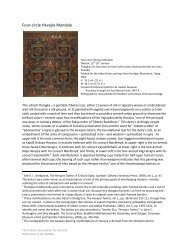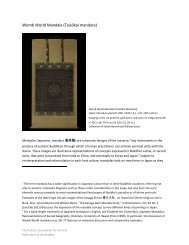Reflections of the Buddha - The Pulitzer Foundation for the Arts
Reflections of the Buddha - The Pulitzer Foundation for the Arts
Reflections of the Buddha - The Pulitzer Foundation for the Arts
Create successful ePaper yourself
Turn your PDF publications into a flip-book with our unique Google optimized e-Paper software.
Lower Gallery<br />
<strong>The</strong> <strong>Buddha</strong>’s Light<br />
Large groupings <strong>of</strong> small-scale gilded sculptures and gold-painted images adorn Buddhist altars and shrines<br />
throughout Asia. In Buddhism gold is <strong>of</strong>ten emblematic <strong>of</strong> <strong>the</strong> radiance <strong>of</strong> enlightenment. <strong>The</strong> labor and great<br />
expense taken to produce <strong>the</strong>se devotional objects also helped everyone involved gain karmic merit. Karma is<br />
<strong>the</strong> universal law <strong>of</strong> cause and effect: Actions in this life will determine <strong>the</strong> <strong>for</strong>m in which an individual will be<br />
reborn in <strong>the</strong> next life.<br />
19. Womb World Mandala (Taizōkai mandara),<br />
mid-13th century<br />
Japan, Kamakura period, 1185 – 1333; hanging<br />
scroll, gold and color on indigo-dyed silk;<br />
35⅝ x 31¼ in.; Collection <strong>of</strong> Sylvan Barnet<br />
and William Burto<br />
At <strong>the</strong> heart <strong>of</strong> <strong>the</strong> central eight-petaled<br />
lotus <strong>of</strong> this mandala is <strong>Buddha</strong><br />
Mahāvairocana, <strong>the</strong> embodiment <strong>of</strong> universal<br />
truth. He sits in meditation emanating a seemingly<br />
infinite number <strong>of</strong> <strong>for</strong>ms in <strong>the</strong> surrounding rows. <strong>The</strong>se<br />
are hierarchically arranged: <strong>Buddha</strong>s, bodhisattvas,<br />
guardians, ghosts, and o<strong>the</strong>r figures and symbols.<br />
Vajrayāna Buddhists in Japan regard Mahāvairocana as<br />
<strong>the</strong> unifier <strong>of</strong> two worlds: <strong>the</strong> spiritual and masculine<br />
Diamond World and <strong>the</strong> material and feminine Womb<br />
World. This mandala thus depicts only <strong>the</strong> female half <strong>of</strong><br />
a pair called <strong>the</strong> Mandalas <strong>of</strong> <strong>the</strong> Two Worlds.<br />
20. Guardian King <strong>of</strong> <strong>the</strong> North (Vaiśravana)<br />
(duo wen tian wang), 1279 – 1368<br />
China, Yuan dynasty, 1279 – 1368; chased,<br />
engraved, and gilded bronze; 14½ x 7¾ x 5<br />
in.; <strong>The</strong> Nelson-Atkins Museum <strong>of</strong> Art, Kansas<br />
City, Missouri, Purchase: <strong>the</strong> Asian Art<br />
Acquisition Fund in memory <strong>of</strong> Laurence<br />
Sickman, F95-4<br />
Vaiśravana, depicted as a <strong>for</strong>midable Chinese general,<br />
secures <strong>the</strong> nor<strong>the</strong>rn direction <strong>of</strong> Buddhist religious<br />
structures. He holds a stupa in his left hand symbolizing<br />
<strong>the</strong> divine treasure house, whose contents he both guards<br />
and gives away. In Central and Eastern Asia, Vaiśravana is<br />
considered to be <strong>the</strong> most important <strong>of</strong> all <strong>the</strong> numerous<br />
Buddhist wealth gods because he provides freedom by<br />
way <strong>of</strong> bestowing prosperity, so that one may focus on<br />
spirituality ra<strong>the</strong>r than on materiality.<br />
44<br />
21. Seated Bodhisattva Avalokiteśvara (Guanyin),<br />
8th century<br />
China, Tang dynasty, 618 – 907;<br />
bronze with gilding; 10¾ x 5⅜ x 3⅝ in.;<br />
Saint Louis Art Museum, Museum Purchase,<br />
36:1933<br />
Adorned with elaborate jewelry and<br />
flowing scarves, this sculpture depicts<br />
Avalokiteśvara sitting with one foot resting on a lotus<br />
blossom. <strong>The</strong> cosmopolitan culture <strong>of</strong> <strong>the</strong> Tang dynasty<br />
led artists toward naturalism, which became fully<br />
expressed in <strong>the</strong> eighth century, when this work was<br />
made.<br />
22. Standing <strong>Buddha</strong> (possibly Śākyamuni)<br />
(Sokkamuni), 8th or 9th century<br />
Korea, Unified Silla dynasty, 668 – 935; gilt bronze;<br />
10¼ x 3� in.; <strong>The</strong> Nelson-Atkins Museum <strong>of</strong> Art,<br />
Kansas City, Missouri, Purchase: William Rockhill<br />
Nelson Trust, 49-18<br />
This statue <strong>of</strong> a <strong>Buddha</strong> represents a time<br />
when Buddhism was an important political, religious,<br />
and cultural <strong>for</strong>ce in Korea. Influenced<br />
by Tang dynasty art, it combines <strong>the</strong> naturalism <strong>of</strong> <strong>the</strong><br />
human <strong>for</strong>m with an abstraction that prevents it from<br />
taking on <strong>the</strong> secularity and realism <strong>of</strong> a portrait.




